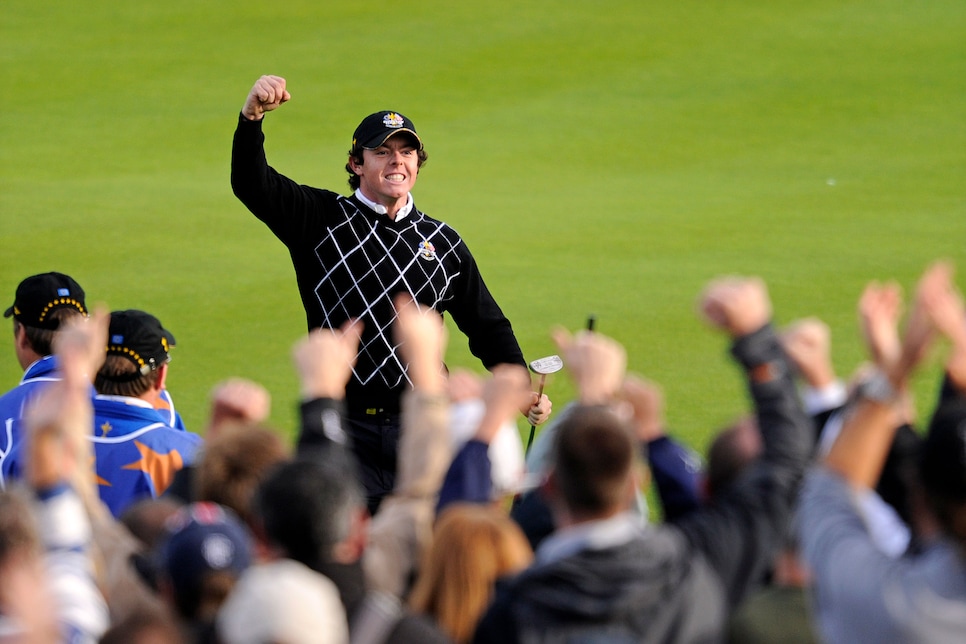The warning sign came after the hollow thwack of Rory McIlroy’s approach, a line drive from what little grass remained next to the service road that dissects the first hole from the 17th.
RELATED: Ryder Cup 2025: What’s the deal with players being paid for the Ryder Cup? A Q&A
On any ordinary Tuesday in New York, this sequence would have drawn sympathetic groans from the gallery and a self-deprecating grin from McIlroy, knowing that even greats like himself are prone to amateur mistakes. Instead, jeers of “USA!” followed and there was no laugh from McIlroy. He cleaned the face of his wedge as he walked towards the green in silence, knowing this rudeness was likely the most hospitality he’d receive the rest of the week. A scene that underlined that of all the things that make an American Ryder Cup different, the starkest is McIlroy, golf’s most popular player, becoming its No. 1 prey.
FULL GOLF DIGEST RYDER CUP COVERAGE HERE
The prediction sounds hyperbolic until witnessing the contradiction in real time. Hours after enduring those chants, McIlroy was swarmed by hundreds of fans at the putting green, shouting his name and thrusting items for him to sign, which he obliged. In a sense this checks out; Scottie Scheffler is the golf’s unquestioned alpha, although no player commands such raw emotional investment from galleries as McIlroy. Fans fell for his prodigious talent, those towering drives and birdie blitzkriegs that look nothing like our games or the games of most of his competitors, yet what kept them tethered was McIlroy’s uncommon willingness to bare himself in victory and defeat.
He is golf’s most compelling protagonist precisely because he refused to hide behind the stoic mask that defines so many others. It was an authenticity that built something, a parasocial relationship so deep that fans genuinely believe they know the “real” Rory. His heartbreaks were ours and his decade-long quest to do what he once did became communal. It has its benefits, being beloved, but it’s also a burden. It’s why McIlroy’s immediate reaction upon winning the Masters in April was falling to the ground, finally letting go of a weight we placed on his shoulders that we never bothered to ask he wanted to bear.
Yet this vulnerability transforms into a liability of sorts in the Ryder Cup’s gladiatorial arena, becoming ammunition for crowds trained to exploit any psychological weakness.
The Ryder Cup operates on an ideological plane that transcends any individual player’s influence, including McIlroy’s. The tournament awakens a strain of nationalistic fervour that manifests in ways far removed from hometown support, some spectators mistaking xenophobia for patriotism. And for McIlroy, becoming a lightning rod for hostile crowds represents something of a perverse honour; this is a tribal theatre, and deepest hatred is reserved for those capable of inflicting the most pain. At Hazeltine National in 2016, he faced perhaps the most hostile crowd in Ryder Cup history—fans who serenaded him with mocking renditions of “Sweet Caroline,” a cruel reference to his broken engagement with tennis star Caroline Wozniacki. Rather than wilt, McIlroy thrived on the animosity, cupping his ear after crucial putts, flexing like a prizefighter, his veins bulging with defiant rage.
He doesn’t just tolerate playing the villain; he relishes it, feeding off the energy of tens of thousands of people desperate to see him fail.

David Cannon
“I think Rory is very comfortable with himself. I think he has thick skin,” teammate Justin Rose said in a press conference. “I think that he can handle the blowback of if he says something that he believes and it is not taken in the right way, I think he’s happy to see it how he sees it and call it how he sees it. And I think he has the freedom on the golf course to just roll with that. I don’t think it sort of layers … what he says I don’t think layers into his golf game, and that’s an amazing talent that he has. I think he always plays incredibly freely, and I think that’s probably the line where Rory can tiptoe better than most.”
For the most part McIlroy has handled the heat as well as one could. Conversely, fan behaviour has deteriorated steadily and threatens to plumb new depths this week, given New York sports fans’ merciless reputation. And, unlike at Medinah or Whistling Straits, McIlroy arrives as an irresistible target after his bewildering spring and summer. What should have been a triumphant victory lap after capping the career Grand Slam at Augusta instead devolved into a disorienting spiral of uncharacteristic behaviour and media confrontations. There were heated exchanges with reporters, actions that felt jarringly out of character and an almost defiant insistence on his right to act without explanation or apology. For a player whose enormous popularity rested on the perception that he remained fundamentally decent—a good guy in a sport sometimes lacking them—these moments felt like watching someone systematically dismantle his own carefully constructed identity.

Rory celebrates his putt on the 17th green on the second day of the 2010 Ryder Cup. GLYN KIRK.
As McIlroy himself has acknowledged, his Slam pursuit consumed him for so long that he never contemplated what would happen after. McIlroy somewhat righted the narrative at Royal Portrush, although that redemption came in the sanctuary of his backyard. The Northern Irishman now must drag his considerable baggage to a place that thrives on sorting through every piece of it.
They will cite his post-Masters behavior. They’ll recall when his emotions consumed him in Rome during that heated parking-lot confrontation with the American team, and when he stormed away from reporters like a wounded animal, tires screeching as he fled the Pinehurst catastrophe after Bryson DeChambeau delivered a crushing blow. His police escort to the 2012 Ryder Cup will inevitably be mentioned. The fact that his private life spilled into public last year will come into play. There’s already proof of concept that his skin is thinner than it has been, taking a heckler’s phone at the Players Championship in a moment that went viral. How McIlroy handles this scrutiny—in both good ways and bad—stands as perhaps the defining storyline of the week and may determine the outcome of the event.

McIlroy (with Andy Sullivan) at the 2016 Ryder Cup at Hazeltine National. 2016 Getty Images
It should be stated that the passionate, unforgiving emotion demonstrated by Ryder Cup partisan crowds is one of the reasons why this event means so much to so many. It’s also why so many golf romantics gravitate towards McIlroy, who broke down completely in 2021 feeling he had let his teammates down. He has never hidden the fact that he cares as deeply and desperately as those outside the ropes do. This week, not so much. This week, the crowd will unleash everything to lift the Americans, and their most-targeted destruction will rain down on McIlroy. They will test every ounce of resilience he has left.
For once, McIlroy’s desires clash with the crowd’s, and perhaps that’s what he needs. Not the embrace of home, but hostility’s brutal honesty that strips away pretense and forces a reckoning of who Rory has become. If what remains proves more predator than prey, it won’t be popular. But it might be necessary.



